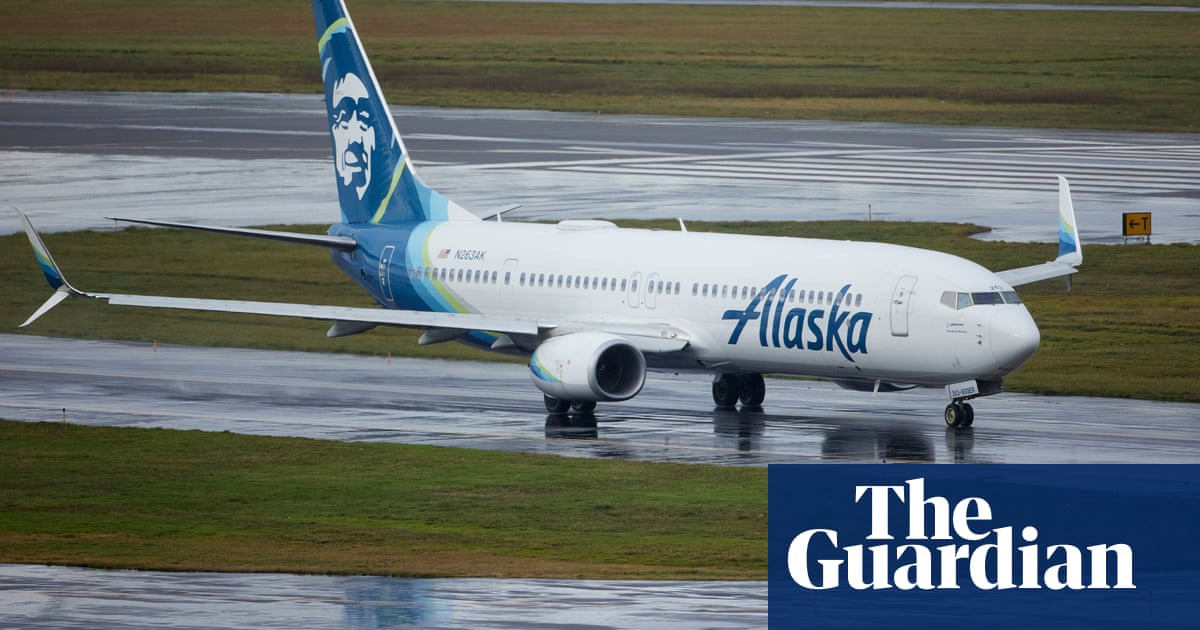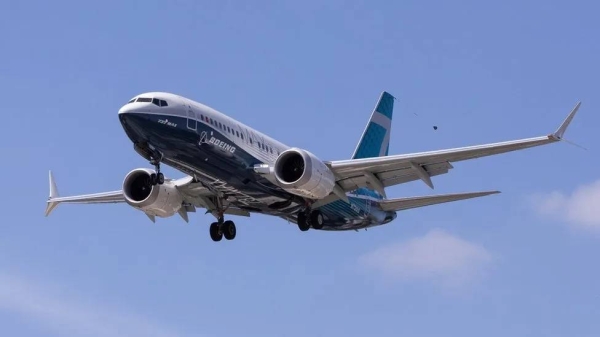
US aviation investigators were on the ground in Oregon on Sunday trying to figure out what caused a door panel to blow out of a brand new Boeing passenger jet just minutes after takeoff, forcing pilots to make an emergency landing with a hole “the size of a refrigerator” in the side of the plane.
The American jet maker was facing fresh scrutiny as regulators temporarily grounded the Boeing 737 Max 9 aircraft after a section of a plugged exit door on an Alaska Airlines flight detached 16,000ft (4,877 meters) above Portland, Oregon, on Friday with 171 passengers and six crew on board. The weeks-old plane had been modified, requiring fewer emergency exits because it had fewer seats.
But investigators – who solicited the public’s help tracking down the Alaska Airlines plane door, which remained missing Sunday – said that initial findings do not suggest a widespread flaw with the Boeing Max 9 aircraft.
“We’ll look at the pressurization system, we’ll look at the door, the hinges,” Jennifer Homendy, chairwoman of the National Transportation Safety Board (NTSB), said at a news conference. “Do we suspect that there is an overall design problem with this plane based on previous accidents involving Boeing Max? At this time, no.”
On Sunday, thousands of passengers, mostly in the US, faced flight cancellations that are expected to continue into next week as airlines called in inspectors to comply with a Federal Aviation Administration (FAA) order.
No one was seriously injured during Friday’s emergency landing. Still, the close call has raised fresh safety concerns about Boeing planes, which took place five years after two fatal accidents left 346 people dead and the US company’s reputation in tatters.
The fatal crashes took place within a few months of each other in 2018 and 2019. Those involved Boeing 737 Max 8 aircraft.
All Max aircraft were then grounded globally for almost two years while company engineers worked to identify the problem – which turned out to be hardware malfunctions and badly designed software that caused the planes to override pilots and plunge from the sky.
In December, Boeing asked airlines to inspect its 737 Max jets for a potential loose bolt in the rudder control system.
Friday’s episode over Portland involved a different model. The 737 Max 9 is now Boeing’s largest single-aisle aircraft with a seating capacity of up to 220. But most airlines have chosen fewer seats, which means the jet’s optional extra door is plugged – or covered.
It was a section of the covered “extra” door in the fuselage – the main body of the plane which includes the cabin, cockpit and cargo compartments – which blew-out midair.
Spirit AeroSystems in Wichita, Kansas, manufactured the fuselage. But Boeing completed the complex, two-tier installation process at its plant just outside Seattle, Washington.
Investigators are expected to examine both factories for potential flaws in design, manufacturing and installation, according to sources cited by Reuters. “The assumption is that it was installed or rigged incorrectly,” one source reportedly said. Neither Boeing nor Spirit have commented.
Door plugs have been used to adapt aircraft and offer flexible seating across the industry for years.
The altitude at which the door panel blew out suggests an issue with pressure, according to Jeff Guzzetti, a former NTSB and FAA official. “It happened at a lower altitude than I would expect, which kind of tells me that the door was not doing its job in keeping the pressure inside of the fuselage,” Guzzetti told NBC’s Today show.
Passengers were shaken up Friday by the near miss. Things weren’t worse likely because the blowout happened before the plane reached cruising altitude, and passengers were still seated with their lap belts fastened.
“Think about what happens when you’re in cruise. Everybody is up and walking, folks don’t have seatbelts on,” Homendy said. “We could have ended up with something so much more tragic.”
No one was sitting directly in the window seat next to the covered exit door. But a teenage boy and his mother were in the middle and aisle seats. “The son’s shirt was completely blown off and his body was completely red, I’m assuming due to the irritation of the wind,” Elizabeth Le, a passenger, told NBC.
Le, 20, said she heard “an extremely loud pop”, looked up and saw a large hole on the wall of the plane a couple of rows away. Another passenger said the gap was “as wide as a refrigerator”.
About 215 Boeing Max 9 airplanes are operating globally, according to Cirium, an aviation data provider. Two US airlines – United and Alaska – account for 70% of the jets in service. Other operators include Panama’s Copa Airlines, Aeromexico, Turkish Airlines, FlyDubai and IcelandAir.
The FAA has grounded and ordered inspections of only the 737 Max 9 aircraft which have been modified to lower seating capacity and therefore include a covered cabin exit door.
In a statement on Friday, Boeing said that safety was its top priority, and its technical team was supporting the NTSB investigation. It added: “We agree with and fully support the FAA’s decision to require immediate inspections of 737-9 airplanes with the same configuration as the affected airplane.”
According to the Aviation Safety Network, an unofficial database compiled from government sources, more than 4,900 people have died in major incidents involving planes from the Boeing 737 family since it was launched in the late 1960s.












